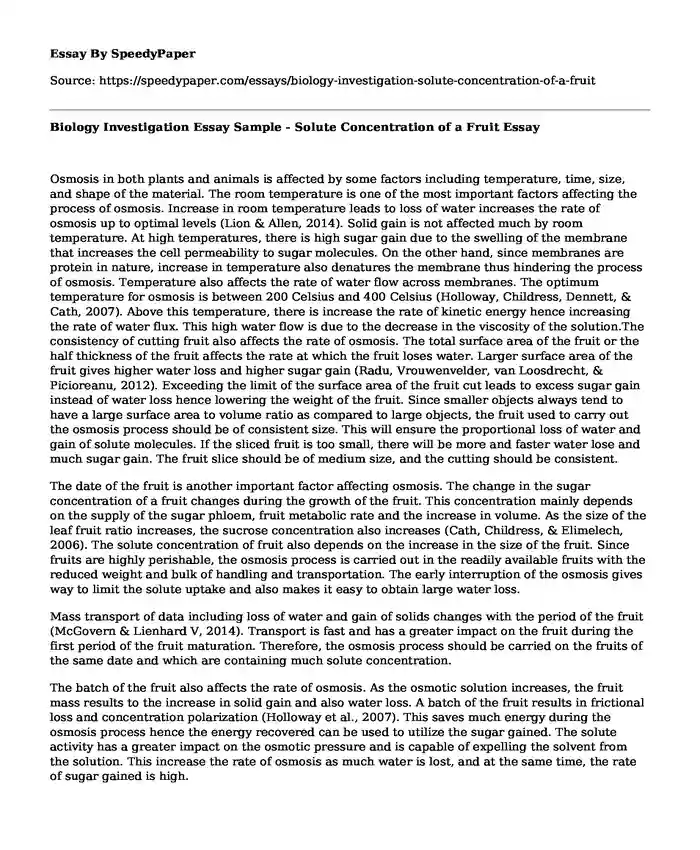Osmosis in both plants and animals is affected by some factors including temperature, time, size, and shape of the material. The room temperature is one of the most important factors affecting the process of osmosis. Increase in room temperature leads to loss of water increases the rate of osmosis up to optimal levels (Lion & Allen, 2014). Solid gain is not affected much by room temperature. At high temperatures, there is high sugar gain due to the swelling of the membrane that increases the cell permeability to sugar molecules. On the other hand, since membranes are protein in nature, increase in temperature also denatures the membrane thus hindering the process of osmosis. Temperature also affects the rate of water flow across membranes. The optimum temperature for osmosis is between 200 Celsius and 400 Celsius (Holloway, Childress, Dennett, & Cath, 2007). Above this temperature, there is increase the rate of kinetic energy hence increasing the rate of water flux. This high water flow is due to the decrease in the viscosity of the solution.The consistency of cutting fruit also affects the rate of osmosis. The total surface area of the fruit or the half thickness of the fruit affects the rate at which the fruit loses water. Larger surface area of the fruit gives higher water loss and higher sugar gain (Radu, Vrouwenvelder, van Loosdrecht, & Picioreanu, 2012). Exceeding the limit of the surface area of the fruit cut leads to excess sugar gain instead of water loss hence lowering the weight of the fruit. Since smaller objects always tend to have a large surface area to volume ratio as compared to large objects, the fruit used to carry out the osmosis process should be of consistent size. This will ensure the proportional loss of water and gain of solute molecules. If the sliced fruit is too small, there will be more and faster water lose and much sugar gain. The fruit slice should be of medium size, and the cutting should be consistent.
The date of the fruit is another important factor affecting osmosis. The change in the sugar concentration of a fruit changes during the growth of the fruit. This concentration mainly depends on the supply of the sugar phloem, fruit metabolic rate and the increase in volume. As the size of the leaf fruit ratio increases, the sucrose concentration also increases (Cath, Childress, & Elimelech, 2006). The solute concentration of fruit also depends on the increase in the size of the fruit. Since fruits are highly perishable, the osmosis process is carried out in the readily available fruits with the reduced weight and bulk of handling and transportation. The early interruption of the osmosis gives way to limit the solute uptake and also makes it easy to obtain large water loss.
Mass transport of data including loss of water and gain of solids changes with the period of the fruit (McGovern & Lienhard V, 2014). Transport is fast and has a greater impact on the fruit during the first period of the fruit maturation. Therefore, the osmosis process should be carried on the fruits of the same date and which are containing much solute concentration.
The batch of the fruit also affects the rate of osmosis. As the osmotic solution increases, the fruit mass results to the increase in solid gain and also water loss. A batch of the fruit results in frictional loss and concentration polarization (Holloway et al., 2007). This saves much energy during the osmosis process hence the energy recovered can be used to utilize the sugar gained. The solute activity has a greater impact on the osmotic pressure and is capable of expelling the solvent from the solution. This increase the rate of osmosis as much water is lost, and at the same time, the rate of sugar gained is high.
References
Cath, T. Y., Childress, A. E., & Elimelech, M. (2006). Forward osmosis: Principles, applications, and recent developments. Journal of Membrane Science. https://doi.org/10.1016/j.memsci.2006.05.048
Holloway, R. W., Childress, A. E., Dennett, K. E., & Cath, T. Y. (2007). Forward osmosis for concentration of anaerobic digester centrate. Water Research, 41(17), 4005-4014. https://doi.org/10.1016/j.watres.2007.05.054
Lion, T. W., & Allen, R. J. (2014). Osmosis with active solutes. EPL, 106(3). https://doi.org/10.1209/0295-5075/106/34003
McGovern, R. K., & Lienhard V, J. H. (2014). On the potential of forward osmosis to energetically outperform reverse osmosis desalination. Journal of Membrane Science. https://doi.org/10.1016/j.memsci.2014.05.061
Radu, A. I., Vrouwenvelder, J. S., van Loosdrecht, M. C. M., & Picioreanu, C. (2012). Effect of flow velocity, substrate concentration and hydraulic cleaning on biofouling of reverse osmosis feed channels. Chemical Engineering Journal, 188, 30-39. https://doi.org/10.1016/j.cej.2012.01.133
Cite this page
Biology Investigation Essay Sample - Solute Concentration of a Fruit. (2022, Apr 14). Retrieved from https://speedypaper.com/essays/biology-investigation-solute-concentration-of-a-fruit
Request Removal
If you are the original author of this essay and no longer wish to have it published on the SpeedyPaper website, please click below to request its removal:
- Free Essay Example on Theological Mentors
- Data and Statistics of NYC Population, Essay Example
- Free Essay in the History of Racism in America
- Astrophysics Essay Sample
- Essay Sample: The Nausea Short Story by Jean-Paul Sartre
- Paper Sample on the Laws Regulating the Cottage Food Industry
- Ocean-Ocean Convergence - Free essay
Popular categories





